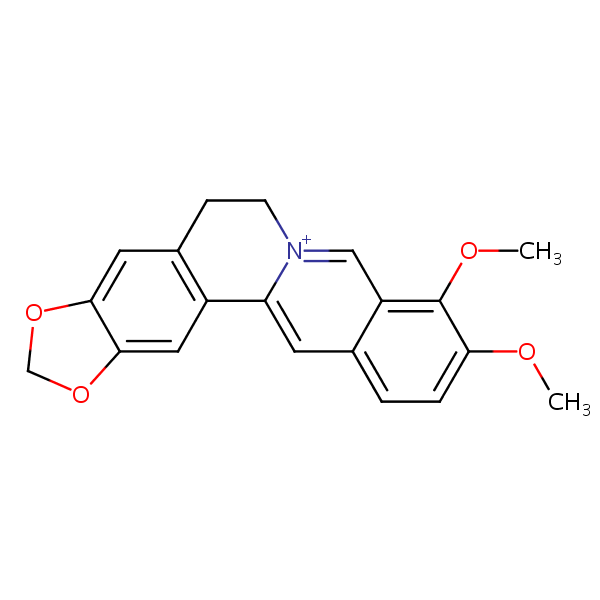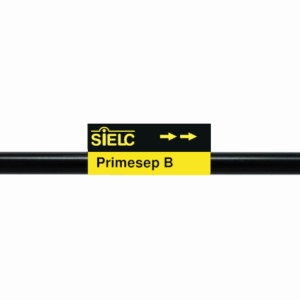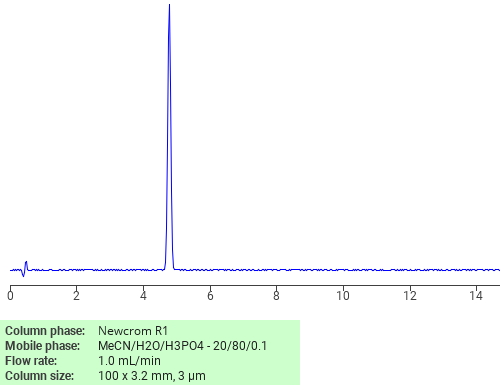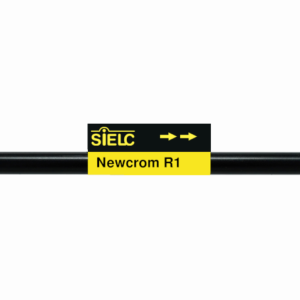| CAS Number | 2086-83-1 |
|---|---|
| Molecular Formula | C20H18NO4 |
| Molecular Weight | 336.366 |
| InChI Key | YBHILYKTIRIUTE-UHFFFAOYSA-N |
| LogP | 0.717 |
| Synonyms |
|
Applications:
Alltesta HPLC Method for Analysis of Epiberberine and Berberine on Primesep B Column
February 3, 2025
Alltesta HPLC Method for Berberine, Epiberberine on Primesep B by SIELC Technologies
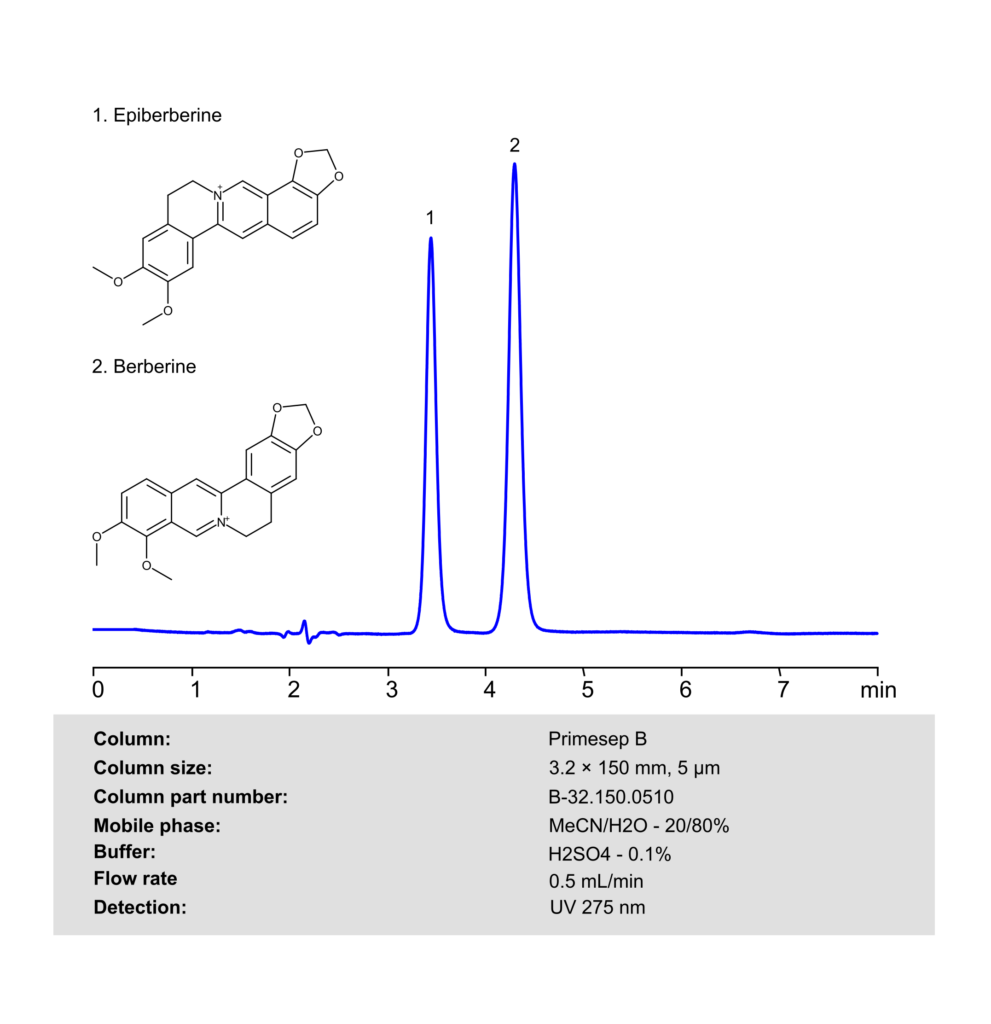
High Performance Liquid Chromatography (HPLC) Method for Analysis of Berberine, Epiberberine
Epiberberine and Berberine are both natural alkaloids found in various medicinal plants, particularly in the Berberis species. They share a similar chemical structure and biological properties but have distinct effects.
Berberine is well-known for its antimicrobial, anti-inflammatory, and metabolic benefits, including blood sugar regulation and cholesterol reduction. It is commonly used for diabetes, gut health, and cardiovascular support.
Epiberberine is a structural isomer of berberine and is believed to enhance its bioavailability and metabolic effects. Research suggests it may contribute to glucose metabolism and lipid regulation, making it a potential complementary compound in berberine-based supplements.
Epiberberine and berberine can be retained and analyzed using a Primesep B mixed-mode stationary phase column. The analysis employs an isocratic method with a simple mobile phase composed of water, acetonitrile (MeCN), and sulfuric acid as a buffer. Detection is performed using UV at 275 nm.
| Column | Primesep B, 3.2 x 150 mm, 5 µm, 100 A |
| Mobile Phase | MeCN/H2O – 20/80% |
| Buffer | H2SO4 -0.1% |
| Flow Rate | 0.5 ml/min |
| Detection | UV 275 nm |
| Class of Compounds | Isoquinoline Alkaloid |
| Analyzing Compounds | Berberine, Epiberberine |
You can view examples of chromatograms obtained using the Allesta instrument and Sielc columns by clicking here.
Application Column
Primesep B
Column Diameter: 3.2 mm
Column Length: 150 mm
Particle Size: 5 µm
Pore Size: 100 A
Epiberberine

Alltesta HPLC Method for Analysis of Berberine on Primesep B
May 30, 2024
Alltesta HPLC Method for Berberine on Primesep B by SIELC Technologies
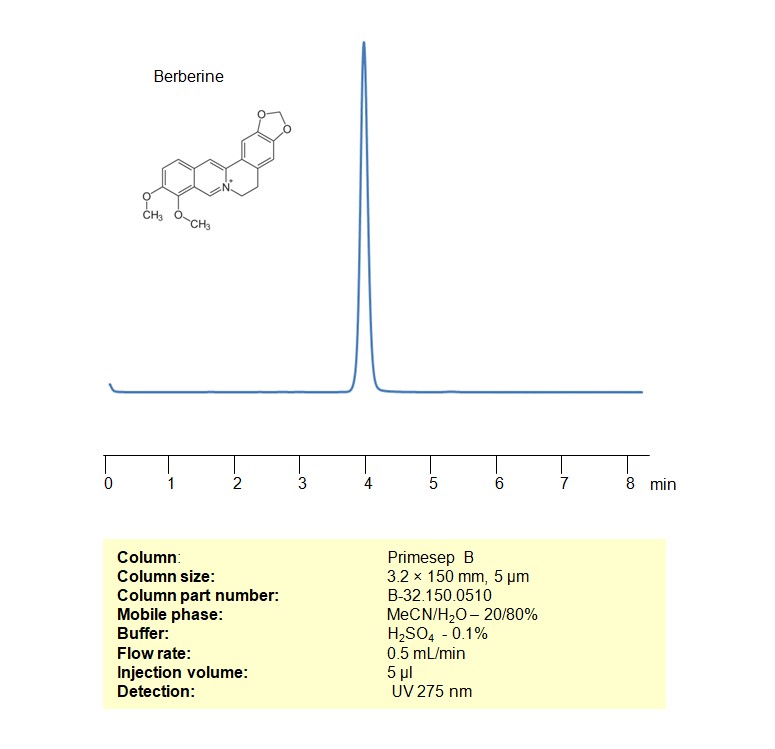
High Performance Liquid Chromatography (HPLC) Method for Analysis of Berberine
Berberine is a naturally occurring alkaloid found in several plants, including the roots, rhizomes, and stem bark of plants such as Berberis species (barberry), Coptis chinensis (goldthread), and Hydrastis canadensis (goldenseal).
Biological Activities:
- Medicinal Properties: Berberine has been used in traditional medicine for its various medicinal properties, including antimicrobial, anti-inflammatory, and antioxidant effects.
- Blood Sugar Regulation: Some studies suggest that berberine may help regulate blood sugar levels and improve insulin sensitivity, making it of interest in diabetes research.
- Cholesterol Management: It has been investigated for potential benefits in managing cholesterol levels.
- Anticancer Properties: Berberine has also shown promise in preclinical studies for its potential anticancer properties.
Uses:
- Berberine supplements are available and marketed for various health purposes.
- In traditional medicine, berberine-containing plants have been used for treating various conditions.
Berberine can be retained, and analyzed using a Primesep B mixed-mode stationary phase column. The analysis utilizes an isocratic method with a simple mobile phase consisting of water, acetonitrile (MeCN), and sulfuric acid as a buffer. Detection is achieved using UV at 275 nm
| Column | Primesep B, 3.2 x 150 mm, 5 µm, 100 A |
| Mobile Phase | MeCN/H2O – 20/80% |
| Buffer | H3PO4 -0.1% |
| Flow Rate | 0.5 ml/min |
| Detection | UV 275 nm |
| Class of Compounds | Corticosteroids |
| Analyzing Compounds | Berberine |
Application Column
Primesep B
Column Diameter: 3.2 mm
Column Length: 150 mm
Particle Size: 5 µm
Pore Size: 100 A

HPLC MS Method for Analysis of Berberine on Primesep B Column
January 29, 2024
HPLC Method for Analysis of Berberine on Primesep B by SIELC Technologies
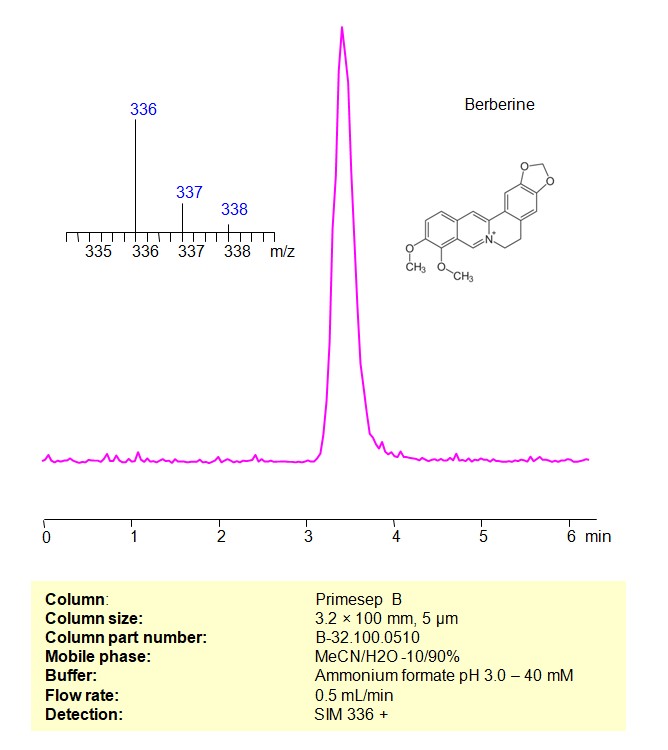
High Performance Liquid Chromatography (HPLC) Method for Analysis of Berberine
Berberine is a naturally occurring alkaloid found in several plants, including the roots, rhizomes, and stem bark of plants such as Berberis species (barberry), Coptis chinensis (goldthread), and Hydrastis canadensis (goldenseal).
Biological Activities:
- Medicinal Properties: Berberine has been used in traditional medicine for its various medicinal properties, including antimicrobial, anti-inflammatory, and antioxidant effects.
- Blood Sugar Regulation: Some studies suggest that berberine may help regulate blood sugar levels and improve insulin sensitivity, making it of interest in diabetes research.
- Cholesterol Management: It has been investigated for potential benefits in managing cholesterol levels.
- Anticancer Properties: Berberine has also shown promise in preclinical studies for its potential anticancer properties.
Uses:
- Berberine supplements are available and marketed for various health purposes.
- In traditional medicine, berberine-containing plants have been used for treating various conditions.
Berberine can be retained, and analyzed using a Primesep B mixed-mode stationary phase column. The analysis utilizes an isocratic method with a simple mobile phase consisting of water, acetonitrile (MeCN), and ammonium formate as a buffer. Detection is achieved using LC MS 336 + positive mode
| Column | Primesep B, 3.2 x 100 mm, 5 µm, 100 A |
| Mobile Phase | MeCN/H2O – 10% |
| Buffer | Ammonium formate pH 3.0 – 40 mM |
| Flow Rate | 0.5 ml/min |
| Detection | SIM 336+ |
| Samples | 0.1 mg/mL in MeCN/H2O – 50/50% |
| Injection volume | 1 µl |
| LOD* | 80 ppb |
| Class of Compounds | Alkaloid, Quaternary ammonium |
| Analyzing Compounds | Berberine |
Application Column
Primesep B
Column Diameter: 3.2 mm
Column Length: 100 mm
Particle Size: 5 µm
Pore Size: 100 A

HPLC Method for Analysis of Berberine on Primesep B Column
January 25, 2024
HPLC Method for Analysis of Berberine on Primesep B by SIELC Technologies
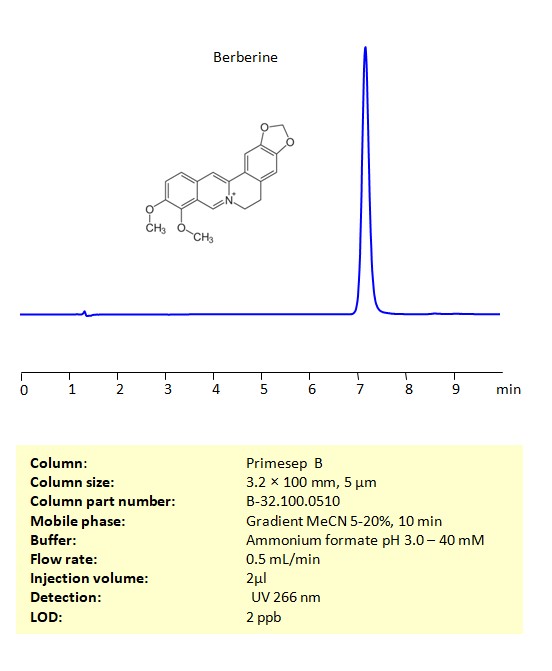
High Performance Liquid Chromatography (HPLC) Method for Analysis of Berberine
Berberine is a naturally occurring alkaloid found in several plants, including the roots, rhizomes, and stem bark of plants such as Berberis species (barberry), Coptis chinensis (goldthread), and Hydrastis canadensis (goldenseal).
Biological Activities:
- Medicinal Properties: Berberine has been used in traditional medicine for its various medicinal properties, including antimicrobial, anti-inflammatory, and antioxidant effects.
- Blood Sugar Regulation: Some studies suggest that berberine may help regulate blood sugar levels and improve insulin sensitivity, making it of interest in diabetes research.
- Cholesterol Management: It has been investigated for potential benefits in managing cholesterol levels.
- Anticancer Properties: Berberine has also shown promise in preclinical studies for its potential anticancer properties.
Uses:
- Berberine supplements are available and marketed for various health purposes.
- In traditional medicine, berberine-containing plants have been used for treating various conditions.
Berberine can be retained, and analyzed using a Primesep B mixed-mode stationary phase column. The analysis utilizes an isocratic method with a simple mobile phase consisting of water, acetonitrile (MeCN), and sulfuric acid as a buffer. Detection is achieved using UV at 266 nm
| Column | Primesep B, 3.2 x 100 mm, 5 µm, 100 A |
| Mobile Phase | Gradient MeCN – 5-20%, 10 min |
| Buffer | Ammonium formate pH 3.0 – 40 mM |
| Flow Rate | 0.5 ml/min |
| Detection | λmax230, 266, 348, 431 nm |
| Samples | 0.1 mg/mL in MeCN/H2O – 50/50% |
| Injection volume | 1 µl |
| LOD* | 2 ppb |
| Class of Compounds | Alkaloid, Quaternary ammonium |
| Analyzing Compounds | Berberine |
Application Column
Primesep B
Column Diameter: 3.2 mm
Column Length: 100 mm
Particle Size: 5 µm
Pore Size: 100 A

Separation of Berberine on Newcrom R1 HPLC column
May 16, 2018
Berberine can be analyzed by this reverse phase (RP) HPLC method with simple conditions. The mobile phase contains an acetonitrile (MeCN), water, and phosphoric acid. For Mass-Spec (MS) compatible applications the phosphoric acid needs to be replaced with formic acid. Smaller 3 µm particles columns available for fast UPLC applications. This liquid chromatography method is scalable and can be used for isolation impurities in preparative separation. It also suitable for pharmacokinetics.
Application Column
Newcrom R1
The Newcrom columns are a family of reverse-phase-based columns. Newcrom A, AH, B, and BH are all mixed-mode columns with either positive or negative ion-pairing groups attached to either short (25 Å) or long (100 Å) ligand chains. Newcrom R1 is a special reverse-phase column with low silanol activity.
Select options